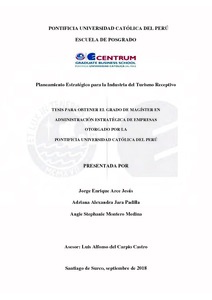Planeamiento estratégico para la industria del turismo receptivo

View/
Date
2018-09-20Author
Arce Jesús, Jorge Enrique
Jara Padilla, Adriana Alexandra
Montero Medina, Angie Stephanie
Metadata
Show full item recordAbstract
La industria del turismo en el ámbito mundial contribuyó en el 2017 con US$8.3
billones (10.4% del producto bruto interno global) y generó 313 millones de empleos, que
equivale a uno de cada 10 empleos en el planeta, además las llegadas internacionales
ascendieron a 1,323 millones (18% del total de habitantes en el mundo). En Perú, el turismo
receptivo contribuyó con US$4,573 millones y generó 1.3 millones de empleo en el mismo
periodo (7.4% de la población económicamente activa), además la llegada de turistas ha
ascendido a 4 millones con un crecimiento promedio de 7.2% en los últimos cinco años.
Respecto al mundo, Perú capta el 0.3% de turistas internacionales, lo que demuestra una
oportunidad para crecer en participación de mercado y por tanto, mejorar la oferta para atraer
mayor número de turistas internacionales. Machu Picchu recibió un millón de turistas en el
2017, en tanto Chichén Itzá (México) y la Torre Eiffel (Francia) fueron visitadas por 2 y 7
millones de turistas respectivamente; cifras que refuerzan la oportunidad de ganar
participación mediante mayor número de turistas. Se identificó a EE. UU., China, y Brasil
como los principales países emisores de turistas al Perú, considerando el gasto promedio
(mayor a US$1,000) y el número de turistas de estos tres países que visita el mundo.
El Perú tiene grandes reconocimientos en el ámbito mundial como: mejor destino
culinario del mundo, mejor destino cultural, destino top mundial, patrimonio mundial de la
UNESCO, entre otros; destacando como país biodiverso a escala cultural, de recursos
naturales y gastronomía, es decir una fortaleza para aprovechar ante las oportunidades y
amenazas del país. Además, a través de la integración de clústeres nacionales, una mayor
inversión pública, privada, y de asociaciones público-privadas (APP), acompañados de
estrategias para desarrollar, potenciar, y mejorar los productos turísticos e incrementar la
participación de mercado; se espera que esta industria duplique sus ingresos, el empleo, la
inversión anual pública, privada, y mixta en los próximos 10 años. The tourism industry worldwide contributed in 2017 with US$8.3 trillion (10.4% of
the global GDP) and generated 313 million jobs, equivalent to one in 10 jobs on the planet,
furthermore, international arrivals closed at 1,323 million in 2017 (18% of the total
population in the world). In Peru, incoming tourism contributed US$4,573 million and
generated 1.3 million jobs in 2017 (7.4% of the economically active population), in addition,
the arrival of tourists has amounted to 4 million with an average growth of 7.2% in the last
five years. Peru received 0.3% of international tourists, which shows an opportunity to grow
in market share and therefore improve the offer to attract a greater number of international
tourists. Machu Picchu received one million tourists in 2017, while Chichén Itzá (Mexico)
and the Eiffel Tower (France) were visited by 2 and 7 million tourists, respectively; figures
that reinforce the opportunity to gain participation through a greater number of tourists. The
United States, China, and Brazil were identified as the main countries that send tourists to
Peru, taking into account the average spending (more than US$1,000) and the number of
tourists from these three countries that visit the world.
Peru has great worldwide recognition as: best culinary destination in the world, best
cultural destination, world top destination, UNESCO world heritage, among others;
highlighting as a biodiverse country on a cultural scale, natural resources and gastronomy,
that is, a strength to take advantage of our opportunities and threats. In addition, through the
integration of national clusters, greater public and private investment and public-private
partnerships (PPP), accompanied by strategies to develop, enhance and improve tourism
products and increase market share; it is expected that this industry will double its income,
employment, annual public, private, and mixed investment in the next 10 years.
Temas
Turismo--Perú
Planificación estratégica
Planificación estratégica
Para optar el título de
Maestro en Administración Estratégica de Empresas
Collections
The following license files are associated with this item:





